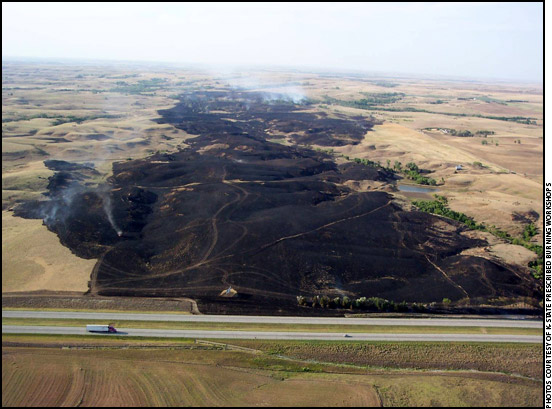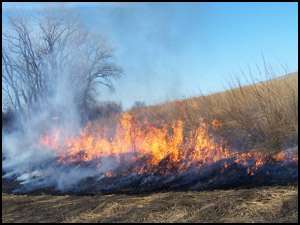
Smoke Modeling Tool Could
Benefit Grassland Managers
The goal of the management plan is to curb smoke during prescribed burns.
Prescribed burning in the Flint Hills has significant economic benefits to grassland managers, but can also potentially cause air quality problems at times. This is especially troublesome for large metropolitan areas such as Kansas City and Wichita because so many people are affected.
New modeling tools and decision support systems being developed at Kansas State University (K-State) could help reduce the potential for air quality problems while still allowing for timely prescribed burning of the Flint Hills, said Carol Blocksome, K-State Research and Extension range management researcher.
This voluntary system will be field-tested during the spring of 2011 in selected areas of the Flint Hills, as part of the State of Kansas Flint Hills Smoke Management Plan, Blocksome said. The test will be the start of a validation and refinement period of the new system that should last two to four years. The system could then be finalized and operational in about five years, if all goes well.
 The decision support system (DSS) being developed by Doug Goodin and colleagues in K-State's Department of Geography is based on a smoke plume transportation model called V-Smoke, used by the U.S. Forest Service. That model attempts to predict where a large plume of smoke will go on a given day, based on environmental conditions and other factors.
The decision support system (DSS) being developed by Doug Goodin and colleagues in K-State's Department of Geography is based on a smoke plume transportation model called V-Smoke, used by the U.S. Forest Service. That model attempts to predict where a large plume of smoke will go on a given day, based on environmental conditions and other factors.
The DSS from K-State uses V-Smoke, along with data on forage biomass conditions on the ground and historical burn patterns in specific counties, to predict how much burning may take place on a given day, how much smoke could occur, and the direction in which the smoke plume is likely to move, Blocksome explained.
K-State's DSS model will be run daily during April, with the results issued as a series of advisories for specific counties, or sections of counties, in Kansas.
"If the DSS model results suggest that burning in a particular location is likely to cause smoke plumes to move over a large metropolitan area, it will flag that location as an area of concern. This will provide burn managers with additional information for deciding whether burning at that location should be recommended," Blocksome said.
Starting in April of 2011, K-State Extension staff and others will ask grassland managers to check the DSS website starting at 6 a.m. the morning before a prescribed burn is planned, she said.
"If the website flags a location as an area of concern, we hope grassland managers in that area will consider calling off the burn that day and waiting for the next opportunity," Blocksome said.
The DSS model is part of the State of Kansas Flint Hills Smoke Management Plan. It is important to the Kansas Department of Health and Environment and the Environmental Protection Agency (EPA) that the state has such a plan and that it is effective, she added. If grassland managers are making a good-faith effort to follow the smoke management plan, it is hoped that this will eliminate the occasional "exceedance," a day on which smoke from Flint Hills burning causes ozone levels to be higher than the National Ambient Air Quality Standards (NAAQS).
Adjusting burning plans to take into account the information provided by the DSS model will be voluntary for now. Whether compliance remains voluntary depends in part on how well the DSS model advisories are accepted by grassland managers in the Flint Hills, Blocksome said.
Depending on when the new website becomes operational, grassland managers can expect to receive more information during the winter and early spring about the new web-based advisory smoke management system from K-State.
 "They will be made aware of how the system will work and the importance of following the voluntary advisories. If all goes well over the next few years, the system will be followed by grassland managers and will keep smoke from causing ozone exceedances in metropolitan areas in Kansas," Blocksome said.
"They will be made aware of how the system will work and the importance of following the voluntary advisories. If all goes well over the next few years, the system will be followed by grassland managers and will keep smoke from causing ozone exceedances in metropolitan areas in Kansas," Blocksome said.
"If this voluntary system is successful, we may be able to avoid having any type of mandatory regulations on prescribed burning in the Flint Hills," she added.
Editor's Note: This article was provided by K-State Research and Extension as a news release.




